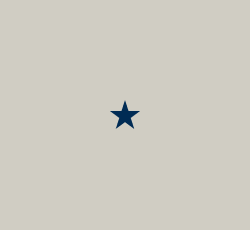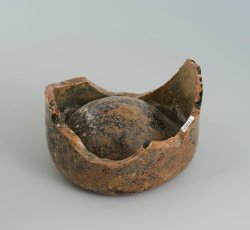House for Families - Page 15 of 18

Limestone marble fragment.
Limestone | Object #: 1839762
Extremely degraded. Does not appear to belong to marble frag 1839784 because to put them together would create an egg-shaped marble.
Explore This Item
Limestone marble.
Limestone | Object #: 1839776
The object pictured here is a simple toy marble. It is made of limestone and polished smooth. While it is always difficult to associate an archaeological item with a singular person, it is possible a toy such as this would have been used if not owned by one of the many enslaved children living ...
Explore This Item
3/4 of a limestone marble.
Limestone | Object #: 1839784
Does not appear to belong to marble fragment 1839762 because to put them together would create an egg-shaped marble. Breaks apart easily
Explore This Item
Blonde shatter from gunflint.
Chert/Flint, Honey-Brown | Object #: 1839790
Blonde shatter is byproduct of making gunflint.
Explore This Item
1725 silver spanish 2-real coin, cut into 1/8
Silver | Object #: 1840590
This wedge of silver is a Spanish 2 real coin that has been cut into a 1/8th portion. Just visible on the piece are the numbers “25,” and small fragment of a crown surmounting a shield bearing the royal arms, indicating the coin was minted in 1725 during the reign of Phillip V. Comprised of pur...
Explore This Item
Quartered white metal coin.
Metal, white | Object #: 1840827
Worn white metal (silver?) coin that has been quartered. Crude and uneven- perhaps a cob coin. Later cob coins cruder- http://www.sedwickcoins.com/articles/colonialcoinage.htm
Explore This Item
Tobacco pipe bowl and rim with unid. molded design on bowl.
Earthenware, ball clay | Object #: 1840846
Design is a dot.
Explore This Item
Dark green wine bottle conical base.
Non-Lead | Object #: 1840855
This fragment is the base from a wine bottle made of dark green glass. Illustrated in this fragment is the “kick” or “push-up,” the inward curving dome at the bottom of the bottle. Wine bottles such as this were primarily imported from Britain and Europe in the eighteenth century, and were ...
Explore This Item
Dark green wine bottle domed base.
Non-Lead | Object #: 1840876
This fragment is the base from a wine bottle made of dark green glass. Illustrated in this fragment is the “kick” or “push-up,” the inward curving dome at the bottom of the bottle. Wine bottles such as this were primarily imported from Britain and Europe in the eighteenth century, and were ...
Explore This Item
Daniel Parke Custis wine bottle seal.
Non-Lead | Object #: 1840926
This fragment is a wine bottle seal, bearing the initials of DP Custis. Wine bottles such as this were primarily imported from Britain and Europe in the eighteenth century, and were commonly used to consume cider, beer, wine or liquors in colonial households of all statuses. Seals such as these...
Explore This Item
Plain weave bast-fiber textile fragment.
Fiber, bast | Object #: 1841151
Once adhered to silver spanish coin 1840590. Came off post-conservation. Reverse of coin date (25) and quatrefoil impressed into textile. Partial pseudomorph, part organic. Bast (vegetal) fiber. Likely linen. Could be hemp. Plain (tabby) weave. Threads appear to be Z-spun.
Explore This Item
Polished raccoon baculum with incised line.
Bone | Object #: 1841966
Missing tip close to thinner end of baculum. Incised line toward thicker end, uneven, and does not totally circle shaft. Iron corrosion on one side.
Explore This Item
Bone fan guard with incised linear decoration.
Bone | Object #: 1842496
Both ends broken. Piece was closer to the rivet and is thinning out toward the top.
Explore This Item
Elephant ivory pistol-grip fork handle
Bone | Object #: 1845353
Only the end of the handle, the pistol grip. Can see the very start of the tang hole--appears cir circular in shape. Thickness is comparable to the pistol-grip handles of forks
Explore This Item
2-piece elephant ivory pistol-grip fork handle
Bone | Object #: 1845372
Full length of handle; circular hole for tang. Length and thickness comparable to other examples of fork handles in the Mount Vernon collection
Explore This Item
2-piece bone utensil handle with carved herringbone decoration
Bone | Object #: 1845379
Both scales have three pins and mirroring decoration. One of the scales has iron adhered to the inside.
Explore This Item
Iron knife blade with rectangular tang
Iron | Object #: 1845430
Completeness includes the tang and part of the blade
Explore This Item
Iron and bone clasp knife
Iron | Object #: 1845468
Very fragmented, one fragment in particular shows the folded position of the knife blade next to the bone handle.
Explore This Item
Bone brush back with central threaded hole.
Bone | Object #: 1845545
Possibly a crumb brush or clothing brush. Row of 6 holes along shorter sides. Row of 13 holes along edge of two longer sides. 2 central rows consist of 4 holes each. Central hole is the largest and is threaded where handle would have screwed in. Tiny hole above central hole. Some holes retain C...
Explore This Item
Coiled copper alloy jewelry wire with suspension loop at each end.
Copper Alloy | Object #: 1849239
One suspension loop incomplete. Identical to 16th/17th century coiled wire illustrated in "Chatelaines: Utility to Glorious Extravagance" on page 28.
Explore This Item